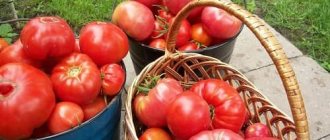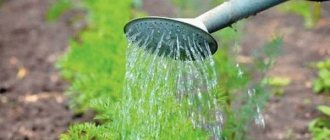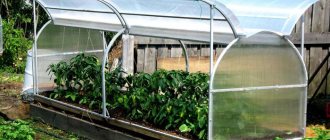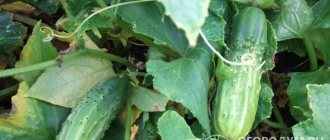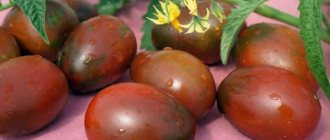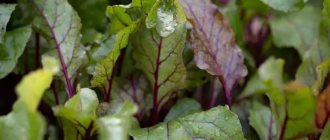Choosing a beet variety
Plant breeding does not stand still. Every year, experts create new beet varieties that are able to adapt to the difficult climatic conditions of our latitudes. The ripening time is reduced and the taste is improved.
The most popular beet varieties
- Early: “Egyptian”, “Red Ball”, “Pablo F1”, “Bordeaux 237”.
- Mid-season: “Sonata”, “Delicacy”, “Valenta”, “Mono”.
- Late: “Matrona”, “Frona”, “Citadel” and “Cylinder”.
- “Crimson Ball”, “Furor”, “Fortune”, “Crosby”, “Tenderness” are considered popular varieties for winter storage.
- If your priority is vegetables with a high content of simple sugars, choose “Mulatka”, “Ordinary Miracle”, “Bonel” or “Bonu”.
- Some of the most productive are considered to be: “Pablo F1”, “Egyptian flat” and “Red hero”.
What is important to consider when choosing a beet variety for planting?
The climate of the region and the timing of ripening are the main guidelines when choosing a variety.
According to the ripening period, beets are:
- Early or precocious. The growing period is 80-110 days.
- Mid-season with a growing season of 110-130 days.
- Late with a ripening period of up to 145 days.
Any variety is suitable for growing crops in central Russia and southern subtropical regions. Focus on the taste of the root crop, yield and disease resistance.
How and when to plant beets in the Urals, Far East and Siberia, where the weather is unpredictable and changeable is more difficult to determine. For these regions, early and cold-resistant varieties are more relevant, ripening as early as August or early September and easily tolerating light frosts.
Also pay attention to the keeping quality of beets. After all, the bulk of the harvest is always sent for storage.
Quality criteria for planting material
Using high-quality seeds when planting table beets increases the chances of high germination and yield. It is best to buy planting material from certified sellers and give preference to well-known manufacturers.
The good quality of the seeds is indicated by their uniform beige color. Spots, stripes and inclusions are a sign of pest infestation. Before purchasing, check the expiration date on the packaging. Expired seeds do not germinate well.
If you prefer to buy ready-made seedlings for planting beets in open ground, choose bushes that already have at least 3 well-developed leaves, a strong neck and an even root. Good seedlings are characterized by succulent leaves with a rich green color and dark veins. Poor planting material is elongated and pale; avoid purchasing it.
When to sow beets before winter: optimal timing
As it was said earlier, the most important thing when sowing winter crops, including beets, is to choose the right time for sowing.
Under no circumstances should you rush; you must wait until a stable low temperature is established and the soil freezes well without any possibility of return thaws. Therefore, it is very important to carefully monitor the weather forecast.
Thus, the approximate time for sowing beets before winter in the middle zone (Moscow region) is the second half of October - November. In more northern regions, it is natural to plant earlier, and in the southern regions - even later.
By the way! Even if there is already early snow on the bed, sowing is quite possible - you just need to sweep the snow out of the furrows with a broom.
Site selection and soil preparation
Beets need to be planted in a properly prepared bed - this will ensure their good germination, resistance to pest attacks and protection from diseases.
Crop rotation
It is recommended to grow beets in beds where legumes, potatoes, onions, and lettuce grew. “Undesirable” predecessors: zucchini, tomatoes, radishes, bell peppers. The root vegetable will not grow well in the area after cabbage, celery or carrots. Experienced gardeners do not recommend planting beets every year in the same bed. Replanting is recommended after a time interval of 3 years.
Preparing the bed
It is necessary to plant beets in a sunny and non-swampy area, away from trees, bushes and buildings.
It is important to prepare the soil for the garden bed in October. To do this you should:
- Dig up the ground, fertilize it with manure or humus. Nutrients should be buried approximately 30 cm.
- If necessary, deoxidize the soil. To do this, we add dolomite flour, slaked lime or wood ash to the upper layers.
- Improve the soil composition with mineral fertilizers. Superphosphate is suitable for these purposes. Before you start planting beets, you need to dig up the soil again in the spring in April or May and form the beds.
Timing for planting beets in open ground
Planting beets with seeds in open ground in most regions begins in the spring; only in regions with a mild climate is it possible before winter. If the seeds are successfully wintered in the ground, you can get an early harvest without growing seedlings. Winter seeds begin to germinate in the spring as the earth warms up.
Pre-winter sowing involves planting beets in open ground in the second half of autumn in cooled soil. Planting seeds is allowed even if snow has fallen. To increase the chances of germination of planting material after winter, choose cold-resistant varieties designed for this purpose.
ARVE Error: src mismatch provider: youtube url:
src in org: https://www.youtube-nocookie.com/embed/fn7Ylxv2zXI?feature=oembed&wmode=opaque src in mod: https://www.youtube-nocookie.com/embed/fn7Ylxv2zXI?wmode=opaque src gen org: https://www.youtube-nocookie.com/embed/fn7Ylxv2zXI
How and when to plant table beets depends on the climatic conditions of the area. For residents of the Middle Zone, it is recommended to begin planting work in the second ten days of May. Gardeners from the southern regions are allowed to plant seeds in early April, and in the regions of the Urals and Siberia - no earlier than mid-May. However, when planning planting, you need to focus not so much on the month, but on the degree of soil warming. It is important that the soil warms up to a temperature of at least 6 °C.
Planting beets in spring in open ground in May is almost a win-win solution.
Seeds can be pre-prepared for faster germination or planted dry in moist, warm soil.
Some rely on information from lunar calendars. Thus determining favorable days for planting beets.
Seed preparation
Most gardeners plant beets in open beds with dry seeds without prior treatment. But I still recommend soaking them to improve germination. Soaking is carried out in a convenient way:
- On damp paper, napkin, natural fabric.
- In moistened sawdust.
When choosing any method, the actions are similar:
- The seed is placed in a moist environment.
- The bowl with seeds is sent to a warm place (temperature not lower than 20-22 C).
- During germination, make sure that the material surrounding the seeds does not dry out - spray it with a spray bottle.
The soaking method is good because it allows the gardener to immediately identify high-quality seeds - they will germinate. Another advantage is that when germinating, beets hatch faster (4-6 days earlier).
Sowing beets for seedlings
To germinate seeds, it is best to buy soil in the store - a special mixture for seedlings. Minerals and other nutrients have already been added to the prepared soil for the active growth of young plants.
Before planting table beets for seedlings, the seeds must be disinfected in a weak solution of potassium permanganate - this will reduce the risk of developing fungal diseases in seedlings. Seeds prepared in this way must be planted in the ground to a depth of 1.5 cm, sprinkled with earth, compacted and irrigated with a spray bottle. For faster germination, you can cover the container with the crops with polyethylene. The covering should be removed for 15-30 minutes for ventilation each time the substrate is checked and irrigated.
ARVE Error: src mismatch provider: youtube url:
src in org: https://www.youtube-nocookie.com/embed/Hfml-YEVe08?feature=oembed&wmode=opaque src in mod: https://www.youtube-nocookie.com/embed/Hfml-YEVe08?wmode =opaque src gen org: https://www.youtube-nocookie.com/embed/Hfml-YEVe08
Seedling care
For containers with seedlings, you should allocate a warm place with good lighting.
It is important to maintain an optimal balance of soil moisture, not allowing it to dry out and at the same time not allowing excess water when watering.
When 2 leaves are formed, the seedlings are picked, leaving a distance between the bushes of at least 3 cm.
Beneficial properties of beets
Since ancient times, beets have been used in traditional medicine to treat many diseases. It is simply a storehouse of vitamins and minerals; it is ideal for various diets, including medicinal ones.
Beetroot juice is considered one of the best vegetable juices. It contains sodium, potassium, phosphorus, calcium, sulfur, chlorine, iodine, iron, copper, vitamins B1, B2, C and P. This juice is rich in easily digestible carbohydrates, but its calorie content is low. Due to its high iron content, it restores and activates blood cells, provides an influx of fresh oxygen, and helps normalize the functions of vesicular respiration. Adding a teaspoon of lime juice to a glass of beet juice increases its medicinal value.
The most beneficial property of beets is that they contain more than 50% sodium and only 5% calcium. This promotes the dissolution of oxalic acid salts in the body, which accumulate in the blood vessels. Beet juice is an excellent solvent for inorganic calcium deposits. Therefore, it is a useful product for the treatment of hypertension, atherosclerosis, heart disease, and varicose veins.
It is important to know that pure beet juice can put a lot of stress on the pancreas and stomach. Therefore, it is recommended to mix beet juice with other juices: carrots, cucumber, etc. Beetroot juice mixed with carrot and cucumber juice is one of the best cleansers for the kidneys and gallbladder.
The pectin substances that beets contain protect the body from the effects of radioactive and heavy metals, inhibit the development of harmful bacteria in the intestines, and help eliminate excess water and cholesterol.
It contains a large amount of betaine - this is a physiologically very important compound for metabolism. Another specific substance in beets, betanin, is a red pigment that restores the respiratory ability of the cell. It is believed that it has an inhibitory effect on the growth of malignant cells. The more intense the color of the root pulp, the more vitamin C, betaine and betanin it contains.
Table beets contain 8-15 percent sugar, protein, fiber, and minerals.
Useful are the leaves, which contain 2-3 times more protein and mineral salts than root vegetables. Beetroot is useful for anemia, atherosclerosis, high blood pressure, cardiovascular diseases, hypertension, obesity.
100 g of beet juice contains 42 kcal, 1.0 g protein, 0 g fat, 9.9 g carbohydrates.
Beets promote weight loss. There is a special mono-diet. It lasts two days. These two days you can only eat beets - boiled or baked. These days, it is recommended to drink green tea, fresh vegetable juices, and still mineral water. It should be remembered that no more than 2 kg of beets can be eaten per day. You need to drink at least 1.5 liters of liquid per day.
Beets can help you reduce blood pressure and associated risks such as heart attacks and strokes. The daily dose is 250 ml of beet juice. But do not forget that beet juice is too concentrated; it is better to use it mixed with other juices - carrot, apple, cucumber.
Beets contain folic acid, which is necessary for normal growth of body tissues. Folic acid is important for the development of the baby's spinal cord in the first three months of pregnancy. It can help prevent spinal defects in the fetus and premature birth. Beets also contain iron, which is a fantastic tonic for expectant mothers who suffer from fatigue during pregnancy. Expectant mothers should remember, however, that boiled or baked milk has lower levels of folic acid than raw milk. For more information about the importance of folic acid during pregnancy, be sure to consult your doctor.
Beets contain the mineral silica. This helps the body better absorb calcium, which is very important for reducing the risk of osteoporosis.
If you put a few mayonnaise jars of water on the window in winter and insert small beets there (you might have thrown them away in the fall), you will soon be able to harvest fresh vitamin leaves for salads and soups.
Step-by-step instructions for planting beets in open ground
When planting beets with seeds and seedlings in open ground, it is important to maintain optimal depth and distance between plants.
Sowing beets with seeds
Should be done when the ground is already warm. When planted in cold soil, the seeds may have time to rot and will not sprout.
The procedure for sowing beet seeds in open ground:
- We make furrows in the prepared bed 2 cm deep (a board or a long ruler is suitable for these purposes).
- We water the furrows with warm water.
- We spread the seeds along the furrows.
- Cover the seeds with a mixture of soil and humus.
After planting is completed, the bed must be watered with warm water.
Planting seedlings
Before planting, the main root of each seedling must be cut to 1/3 of its length. This will help prevent the rhizome from bending.
To plant in the bed, make depressions approximately equal to the length of the roots so that they are positioned straight. Plants need to be placed in holes and sprinkled with soil, and then watered generously. When planting beet seedlings in spring in open ground, the seedlings need to take root.
It is important in the first couple of weeks to prevent the plants from being exposed to the scorching rays of the sun and to protect them from accidental frosts. To do this, immediately after planting the seedlings, we cover them with a special covering material.
Beet sowing scheme
Approximate scheme for planting beets in a garden bed
To plant seeds, you need to mark rows on the garden bed 2-3 cm deep, with a distance of 20-25 cm from each other. Place the seeds from each other at a distance of 5-10 cm (based on the expected size of the future root crop).
Planting care
Caring for beet crops after germination includes such mandatory procedures as thinning, weeding and loosening, fertilizing, protection from diseases and pests.
Thinning
From one beet fruit there are 2 to 4 sprouts. This feature makes the thinning procedure one of the main elements of agricultural technology. If you miss the moment, the seedlings will drown out each other, “expire”, that is, they will freeze in growth and will not form full-fledged root crops.
- The first thinning is carried out as soon as the shoots appear, at the stage of 2–3 leaves. Plants are left densely, every 2-3 cm, in order to subsequently select stronger specimens. At the same time, weeds are removed and row spacing is loosened.
- The second thinning is in a month. The strongest plants are left at intervals of 6–8 cm. At this time, the beets, which have been sitting in place for more than a month, actively begin to grow and form heads.
- The third thinning is a check, carried out when small root crops appear (3–5 cm in diameter). The distance between them is at least 15 cm, but it is also undesirable to prevent the vegetable from overgrowing.
Watering
Beets love moisture, especially at the beginning of the growing season. During the month, it needs abundant watering at least once a week. Further, as the soil dries out. A month before harvesting, stop watering, otherwise the root crop will not lie well.
The most effective way to reduce evaporation and maintain soil breathability is mulching. If you have problems with water in your area or you rarely come to your dacha, cover the rows with a layer of mulch consisting of unfertilized weeds, straw, last year’s leaves, and high-moor peat. It will retain moisture, prevent weeds from germinating, save you from loosening, and as it decomposes it will serve as a light organic fertilizer.
Feeding
To form a good harvest, it is quite acceptable to apply the full amount of fertilizer once when planting beets in the ground. If you see that the plants are developing slowly, the roots are not growing, feed them.
After the second breakthrough, water the crops with a solution of mineral fertilizers containing nitrogen, for example, ammonium sulfate at a rate of 30–50 g/m².
Note! To avoid overdoing it with nitrates, the necessary nitrogen and potassium can be added not in mineral form, but with herbal infusions. They are made like this: fresh plant waste is poured into a container in equal proportions, filled with warm water, and left to infuse for a week. The resulting fermented starter is added during watering.
The quality of the fruit is affected by the presence of microelements in the soil. To stimulate the growth of the beet head and increase its sugar content, use Makbor - an effective fertilizer consisting of boron, magnesium and calcium. Among folk remedies, simple table salt works well - a tablespoon per 10 liters of water.
Pest protection
When agricultural practices are violated, crops are attacked by pests - beet flies, aphids, flea beetles. They damage the tops, which leads to oppression, delayed development, and sometimes death of the plant. They fight this problem by spraying with an infusion of ash, tobacco dust, and onion peels. Among the biochemical preparations used are Iskra Bio, Bi-58, Aktofit, Calypso, Konfidor.
Temperature and light conditions
To get a good harvest, you need not only to know how to plant beets correctly, but also to provide them with proper care and growing conditions.
Beets respond to good lighting by actively gaining root mass. Light is important throughout the growing season.
Temperature affects the rate of seed germination. At + 20 °C, sprouts appear within a week. Young plants are sensitive to high temperatures - if the thermometer is above + 30 ° C, they may die. Try to shade the fry in this heat. Grown beets with 3-5 developed leaves become resistant to heat and sudden temperature changes.
The best conditions for beet growth
Beetroot is called a long-day plant.
The main secret to growing a rich beetroot harvest is providing the necessary conditions. This vegetable cannot be called too demanding of the environment, but you should not neglect the recommendations described below.
| № | Condition | detailed information |
| 1 | The soil | Fertile, loose soil is suitable for growing sugar beets. You can sow the seeds of the fruit in medium-loamy chernozem or peat bog. In this case, the soil should not be too acidic or alkaline. Such an environment leads to the fact that the vegetable quickly becomes unsuitable for further storage and consumption. |
| 2 | Humidity | The plant must be watered regularly, but overwatering is strictly contraindicated. Therefore, watering should be reasonable and not too frequent. At the same time, excessive dryness of the soil should not be allowed. If this happens, the shelf life of the root crop will be significantly reduced. |
| 3 | Temperature | For intensive vegetable growth, medium temperatures are required. The best condition is at least 8-10 degrees. |
| 4 | Lighting | Beetroot is called a long-day plant. Therefore, it needs to be provided with good and long-lasting lighting - at least 10-12 hours. For this reason, it should be planted only in areas of open ground that receive sufficient sunlight. |
The soil should be fertilized before sowing. It must be enriched with substances necessary for the growth of this root crop. Therefore, shortly before gardening, it is recommended to add compost or mineral fertilizer to the ground where the beet grains will be placed.
If the plant is provided with the proper conditions, the first shoots can be observed within 8 days. This is only possible if the ambient temperature does not fall below 5 degrees. At higher temperatures, the germination process will take 3-5 days.
Weed control, loosening
Weeds absorb nutrients and moisture from the soil, which is why our plants will experience their deficiency. Timely removal of weeds is the key to obtaining the desired result, so do not neglect it. After removing the grass, you need to loosen the ground. This must be done carefully to avoid damaging the plants. It is recommended to loosen the soil with each weeding, preferably even more often.
Beet diseases and pests
The crop has good immunity, but due to violation of growing rules or deficiency of nutritional components, plants sometimes get sick. A signal of poor health of the plant is the redness of the beet leaves.
There are several diseases that most often affect beets:
- Fomoz. The appearance of yellow-brown spots on beetroot foliage is the main sign of the disease. The fight comes down to treating the leaves with Fundazol. We dilute the drug according to the instructions on the package.
- Cercospora blight. The disease is characterized by the appearance of red spots on the front side of the leaves, and on the back - a gray coating. The fight comes down to adding wood ash or potassium chloride to the soil.
- Fusarium. A fungal disease in which the foliage first withers and then turns yellow. To destroy the fungus, you need to treat the plants with boric acid.
Common pests include nematodes, mole crickets and beet flies. If plants are attacked by nematodes, they should be pulled out and destroyed - there are no other control measures.
If mole crickets are detected, it is necessary to treat the crops with insecticidal preparations. Scattered granular poison, for example, “Thunder,” works well against mole crickets.
Useful tips for gardeners
The taste of beets is affected not only by its variety, but also by growing conditions. The taste also depends on proper soil preparation, regular watering and proper fertilizing. To get sweet and juicy beets, follow simple rules:
- choose varieties with a high sucrose content;
- avoid growing crops in acidic soils;
- Water the beets with an ash-salt solution (a bucket of water, 2 cups of wood ash and a tablespoon of salt).
What to do if beets do not sprout
Germination depends not only on the correct choice of variety and timing of planting beets, but also on other factors:
- use of low-quality seeds;
- non-compliance with care recommendations;
- improper placement of beds (beets love sunlight and warm soil).
If the beets have not sprouted in due time, it would be advisable to buy other seeds and germinate them first.
Other features of planting and growing
How to avoid common mistakes that are often made when growing beets:
- do not plant late varieties of beets too early - the fruits will be tough and tasteless;
- so that the crop has time to ripen when grown in cold regions, do not use seeds, but plant beet seedlings in open ground;
- when sowing before winter, choose special winter varieties - those that are not cold-resistant often freeze and do not sprout;
- choose a good sunny place;
- beets “do not like” stagnant moisture, make well-draining soil in the garden bed;
- do not overuse fertilizers - with an excess of nutrients, the pulp becomes loose with numerous cavities;
- for irrigation, use warm, settled water;
- mulch the soil with dried grass - this way you can reduce the amount of watering on hot days.
ARVE Error: src mismatch provider: youtube url:
src in org: https://www.youtube-nocookie.com/embed/vXdo9NtM13c?feature=oembed&wmode=opaque src in mod: https://www.youtube-nocookie.com/embed/vXdo9NtM13c?wmode=opaque src gen org: https://www.youtube-nocookie.com/embed/vXdo9NtM13c
Why sow beets in the fall before winter: what are the advantages
The meaning of winter sowing of beets and other crops is as follows:
- You save precious spring time, because in late autumn there are practically no worries, and, on the contrary, you want to do something.
- Thanks to this winter sowing, you get an earlier harvest (by about 2-4 weeks).
- Plants whose seeds undergo natural stratification (and this is the main point) grow stronger and healthier.
Note! Of course, one cannot do without shortcomings . If you sow too early and thaws begin soon, the seeds will germinate and die from frost. Spring flooding of the bed also leads to the death of your seedlings.
However, you can avoid the above-mentioned troubles if you plant beets before winter according to all the rules and recommendations, especially with regard to sowing dates.
Important! Winter crops, unfortunately, are not suitable for further long winter storage. long-term storage methods is unlikely to be useful to you , but about the timing of harvesting, it may partly be useful.




